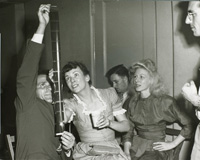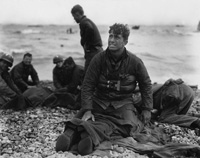Original Members
Most of the members of the Photo League during its first five years were New Yorkers who shared a common belief in the power of photography to change social conditions. The definition of this kind of photography was a recurring topic among League members, who variously referred to “realistic,” “meaningful,” or “sociological” photography. Separate philosophic approaches led to the formation of two major production groups: the Feature Group, led by Aaron Siskind, who believed in “learning by doing” and eventually turned away from documentary to an exploration of expressive form; and the Documentary Group, led by Sid Grossman, who felt that all photographers should have an understanding of photographic history and traditions before they began to develop a personal style. Both positions were fairly avant-garde at the time, considering that the first American scholarly publication on photography, by Beaumont Newhall, was published in 1937. Whatever their individual approaches, all members were in agreement about the transformative power of the medium; as Sol Libsohn stated it, “The camera is itself a form of discipline.”
Arnold S. Eagle
(born 1910, Hungary; died 1992)
One third of a nation, 1936
Miriam and Ira D. Wallach Fund
Car passing car viewed from steering wheel, 1950s
Miriam and Ira D. Wallach Fund
Penn Station
Paste-up for Fortune magazine, September–October 1942
“Inspired by the play ‘… one-third of a nation,’ Mr. Eagle’s [sic] and Mr. [David] Robbins created a series of pictures showing present conditions in the Chelsea and East Side slum districts. The value of this series can further be gauged by the use being made of these photographs to build the movie sets for the film version of ‘… one-third of a nation,’ now in the process of production.”
—“Photo League Members Exhibit at Federal Art Gallery,” Photo Notes, October 1938
Morris Engel
(born 1918, New York, New York; died 2005)
[Canal Street], 1991
Chromogenic print
“Engel sees his subjects very specifically and intensely. They are not types but people in
whom the quality of the life they live is vivid— unforgettable.”
—Paul Strand, “Engel’s One Man Show,” Photo Notes, December 1939
George Gilbert
(born George Gelberg, 1922, Brooklyn, New York)

Morris Huberland, Elizabeth Timberman and Ed Schwartz judging a Photo League Photo Hunt, August 2, 1947
Gift of George Gilbert
Brooklyn Botanical Garden. Woman and boy running in the rain, 1941
Memorial Day marchers, 1942
Miriam and Ira D. Wallach Fund
Sid Grossman
(born 1914, New York, New York; died 1955)
Chelsea, from the Documentary Group’s Chelsea Document, 1938
Purchase made possible through the estate of Leroy A. Moses
Coney Island (two women in bathing caps), 1947–48
Purchase made possible through the estate of Leroy A. Moses
“Today Chelsea is by no means a suburban paradise. The figures say it is closer to an urban hell, its streets thronged with the city’s trucking, the majority of its homes guiltless of plumbing and steam heat, its children robbed of sunlight, air and play space.”
—Elizabeth McCausland, “The Chelsea Document,” Photo Notes, May 1940
Morris Huberland
(born 1909, Warsaw, Poland; died 2003)
East Side NYC, ca. 1945
Miriam and Ira D. Wallach Fund
“His pictures are deliberate, studied, almost arranged, but warm with understanding.…
His subjects are not really camera-conscious, in the static sense, but merely curious and absorbed. It is as if the photographer had suddenly asked his subjects to stop whatever
they were doing, please, and sit for his camera.”
—Jacob Deschin, “Huberland-Burkhardt, A Review,” Photo Notes, Fall 1948
Sidney Kerner
(born 1920, Brooklyn, New York)
N.Y.C., 1939
Miriam and Ira D. Wallach Fund
Reflections in a hallway, 1995
Chromogenic print
Gift of Sidney Kerner
Sol Libsohn
(born 1914, Harlem, New York; died 2001)
A self-taught photographer who originally earned his living documenting paintings, Libsohn co-founded the Photo League with Sid Grossman. Libsohn was an important teacher at the League as well as a member and leader of numerous production groups. In addition to freelance work for numerous magazines, he also was employed by Roy Stryker for the documentary project of Standard Oil Company of New Jersey (later Exxon), the Federal Art Project, and Princeton University, where he taught art and photography to disadvantaged youth in the Summer Program. Libsohn was a personal acquaintance of Romana Javitz, head of The New York Public Library’s Picture Collection from 1929 to 1968, who sought out his work for the Library.
Building a tanker, Sunship Building Company, Chester, PA., Standard Oil Company,
April 1944
Havana, Cuba, ca. 1950
Big Bill Broonzy, ca. 1951
[Camel cigarettes billboard], 1950s–60s
Ringling Brothers clown, 1954
Shoeshine, 45th Street East, 1963
Surplus Navy arctic windbreakers, Modell’s 42nd St., 1950s–60s
Penny arcade, Broadway between 42nd and 43rd Street [Beatles window display], 1964
Playground, Newark, New Jersey, 1964
Richard A. Lyon
(born 1914, New York, New York; died 1994)
Kids & guns, ca. 1938
Legs, NYC, 1970s, printed 1983
Jack Manning
(born Jack Mendelsohn, 1920, New York, New York; died 2001)
Readers in the Main Reading Room, New York Public Library, 1941
Contact sheet
Gift of Jack Manning
Readers in the Main Reading Room, New York Public Library, 1941/1995
Published in The New York Times, May 7, 1995
Gift of Jack Manning
Walter Rosenblum
(born 1919, New York, New York; died 2006)
Tar Beach. Pitt Street, New York, 1938, printed later

Rescue on Omaha Beach
[D
Day morning], 1944, printed later
“The end of the war will see our art given new impetus by the democratic forces unleashed by a progressive victory. We will be faced with tremendous possibilities that we must even now begin to anticipate. Yep. We have a great deal to look forward to.”
—Walter Rosenblum, “Letter,” Photo Notes, July 1944
Arthur Rothstein
(born 1915, New York, New York; died 1985)
Cow hands, Quarter U Ranch, Montana, Farm Security Administration, June 1939
“… in the future our descendants will say when looking at these pictures: ‘those were the faces of our ancestors who overcame their difficulties with heroic determination and forced themselves upward into the sun and into the golden air so that we might live in a world of beauty and justice.’”
—Robert Disraeli, “The Farm Security Administration,” Photo Notes, May 1940
Edward Schwartz
(born 1906, Brooklyn, New York; died 2005)
Watchers of a Soap Box Derby, the biggest event on a Sunday in Charleston, W. VA., 1941
Gift of Edward Schwartz
Michael and Robert Rosenberg [sons of Julius and Ethel Rosenberg], 1952
Gift of Edward Schwartz
Aaron Siskind
(born 1903, New York, New York; died 1991)
Pleasures and Terrors of Levitation 477, 1954
Gift of Tennyson and Fern M. Schad
Pleasures and Terrors of Levitation 14, 1954
Gift of Tennyson and Fern M. Schad
Lou Stoumen
(born 1917, Springtown, Pennsylvania; died 1991)
Stone head with melted face found in blast area, Hiroshima, 1982
Shirley Carter Burden Collection
Yank’s Magic Carpet (Calcutta: Yank, The Army Weekly, 1945)
A souvenir booklet with layout, text, and photography by Stoumen
“For the power of the camera is indeed that it can speak visually: that it enables a man to select from the images that cross his retina one incisive moment of visual meaning, to isolate and fix it forever, and through it to commune so intimately with his fellows that they see the world through his eyes!”
—Louis Clyde Stoumen, “The Camera and the Audience,” Photo Notes, Spring 1949
Weegee
(born Usher Fellig, 1899, Zloczew, Poland; died 1968)
Another Sunday morning shot, in Central Park, it was just before winter, squirrels were gathering stuff for cold weather. This fellow slept right on while I snapped him. I was tired from reading all night & wouldn’t have minded joining him. –Weegee, n.d.
Bequest of Peter Miccuci
Sawdust V set afire (V-J Day, 1945)
Miriam and Ira D. Wallach Fund
“Many photographers live in a dreamworld of beautiful backgrounds. It wouldn’t hurt them to get a taste of reality to wake them up. Any one who looks for life can find it. And they don’t need to photograph ashcans. The average camera fan reminds me of polyanna [sic], a lolly pop in one hand, and a camera in the other.”
—Weegee, “Murder Is My Business,” Photo Notes, September 1941
Dan Weiner
(born 1919, New York, New York; died 1959)
Truman lays the cornerstone of the UN Building, 1949
Miriam and Ira D. Wallach Fund
“With monotonous regularity, certain fashionable names in photography appear in museum shows without, I feel, due consideration to the real value of their work. The emphasis in the contemporary scene is on the magazine photographer, who thru [sic] his connection with a mass medium of communication and limitless possibilities photographically, should be making important contributions.… In the final analysis those photographs that find their way to the museum walls should represent not the momentary shock values necessary to catch the eye in publications, but the enduring qualities inherent in a work of deep conception, honesty, and visual acumen.”
—Dan Weiner, “50 Photographs by 50 Photographers,” Photo Notes, Fall 1948
Sandra Weiner
(born Sandra Smith, 1921, Drohiczan, Poland)
Boy smoking, 1939
Miriam and Ira D. Wallach Fund
Assassinated, 4-4-68, 1968
Miriam and Ira D. Wallach Fund
Next Section